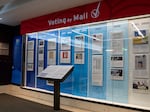
The “Voting by Mail” exhibition at the National Postal Museum in Washington, D.C., tracks the long history of mail-in voting in the United States with a selection of historical ballot envelopes, election mailers and photographs.
Zayrha Rodriguez / NPR
Four years ago, millions more voters in the U.S. became familiar with voting by mail.
But a new exhibition at the Smithsonian's National Postal Museum opens Saturday as a reminder that earlier generations of voters used the postal service to cast absentee ballots decades before the COVID-19 pandemic upended the 2020 election.
“It was sort of presented during the pandemic as a new concept for a lot of folks who may have never encountered it before,” says Carrie Villar, director of curatorial affairs at the Washington, D.C., museum that is open free to the public. “We thought with this presidential election coming up in 2024, there could be no better place than the National Postal Museum to have an exhibit where we talk about voting by mail and how it's not a new thing. It's been around for over 160 years in various forms.”
On a wall nestled within the museum’s stamp salon, Villar’s team of curators has assembled a small selection of mail-in ballot envelopes, election mailers, photographs and other artifacts to lay out a timeline that begins with the Civil War election of 1864, which is considered the start of large-scale use of voting by mail in the United States.
“That was the big moment that voting by mail stepped up to a national stage,” Villar says, noting that there were earlier examples at the state and local levels dating back to the 18th century.
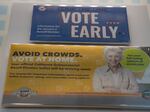
The exhibition includes election mailers sent in Georgia’s Fulton County and California’s Orange County ahead of 2021 elections to encourage voters to cast their ballots by mail.
Zayrha Rodriguez / NPR
Villar hopes the exhibition can be expanded one day with more artifacts to fill in gaps in its presentation of mail-in voting’s extensive history.
Visitors, for example, won’t find any items on display that represent the spread of baseless claims of widespread absentee ballot fraud during the 2020 election, or how those allegations have fueled distrust of the voting method among conservatives, although the exhibition does note that the pandemic “brought attention to concerns over election integrity that have existed since the beginning of voting at polling places and by mail.”
The museum is counting on the public, in part, to help more fully tell the story going forward with donations of historical objects and archival material.
“We're actively collecting through this election and beyond because we want to continue the story,” Villar says. “There's so much being printed and put out there that it gets thrown away. We would love to see some of that saved.”
Even with its limited look at voting by mail through the years, Villar adds she hopes visitors who are eligible to cast a ballot will leave “inspired to vote however they choose to do it and to know more that voting by mail has a long history of successfully being carried out.”
Here are some highlights from the exhibition “Voting by Mail: Civil War to Covid-19”:
An envelope used during the 1864 election to mail a sheet tallying the votes of Civil War soldiers from Ohio's Highland County at a Union Army field hospital in Georgia
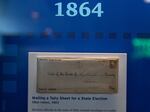
An envelope used during the 1864 election to mail a sheet tallying the votes of Civil War soldiers from Ohio’s Highland County at a Union Army field hospital in Georgia
Zayrha Rodriguez / NPR
“Different states had different approaches, but they wanted to give a way for soldiers who are away, out of state at war to have a chance to vote in the election,” Villar says. “Voting by mail and absentee voting for our military has really been a key part that has moved voting by mail forward in the last 160 years. And when you think about it, these men and women are out there risking their lives for our country and disenfranchising them by not being able to vote in an election doesn't make a lot of sense.”
A photo of Japanese American citizens waiting for their absentee ballots to be notarized in 1942 while they were wrongfully incarcerated at the Tule Lake prison camp in California during World War II
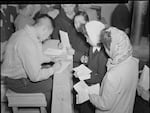
A photo of Japanese American citizens waiting for their absentee ballots to be notarized in 1942 while they were wrongfully incarcerated at the Tule Lake prison camp in California during World War II
National Archives
“It's a really powerful story and one that really makes you think about what it means to be American and that right to vote that we may sometimes take for granted,” Villar explains. “The people who were incarcerated in these camps had to battle through a lack of knowing what their state requirements were for allowing them to vote. They were limited in the information they were getting from back home about who to vote for. These good citizens who were in these camps by their own government still took the time and effort to exercise that duty to vote.”
An unused federal war ballot issued in 1944 for absentee voters serving in World War II
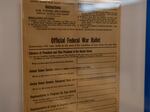
An unused federal war ballot issued in 1944 for absentee voters serving in World War II
Zayrha Rodriguez / NPR
“It's a big undertaking to get all of this material out all around the world during war. And so they ended up printing these official ballots that didn't have the candidate names in them yet,” Villar explains. “The voter would actually handwrite in who they were voting for. And then someone on the other end would have to read it. They had to sort of decipher out and make sure that the right candidate was getting a vote. It's unusual to see a ballot without any names on it.”
An informational card the U.S. Postal Service sent in 2020 to help voters prepare to vote during the COVID-19 pandemic
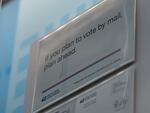
An informational card the U.S. Postal Service sent in 2020 to help voters prepare to vote during the COVID-19 pandemic
Zayrha Rodriguez / NPR
“The messaging around voting by mail is so challenging,” Villar says. “The Postal Service sent this out, trying to educate postal customers, and soon realized that there isn't a one-size-fits-all direction for voting by mail and that every voter needs to check with their own state and local rules and regulations. There was some backlash to this postcard, and they ended up having to correct the information.”
For those who can't stop by in person before the exhibition is set to close on Feb. 23, 2025, a virtual exhibition is available on the museum's website in English and Spanish.
Edited by Benjamin Swasey
Visuals edited by Grace Widyatmadja
Copyright 2024 NPR
